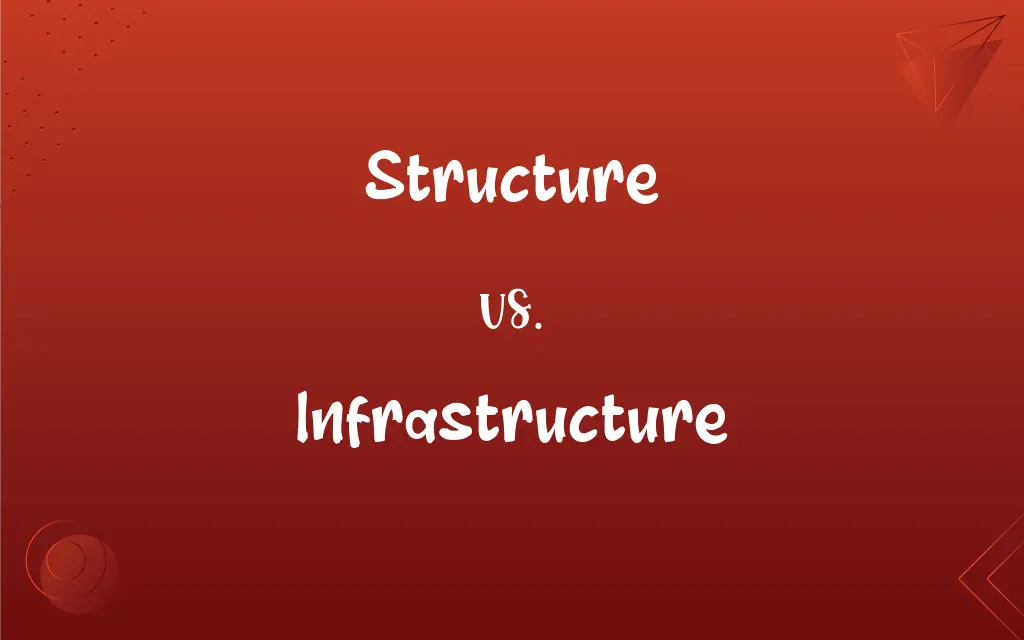Structure vs. Infrastructure: What's the Difference?
Edited by Aimie Carlson || By Janet White || Published on December 27, 2023
Structure refers to the arrangement and organization of parts within a whole, while infrastructure is the fundamental facilities and systems serving a country, city, or area.

Key Differences
Structure is a general term for the arrangement or organization of interrelated elements in a material object or system, while infrastructure refers specifically to the basic physical and organizational structures and facilities (e.g., buildings, roads, power supplies) needed for the operation of a society or enterprise.
The term structure is used to describe the design and makeup of both physical constructions and abstract systems. In contrast, infrastructure is a term used to describe essential systems and services such as transportation, communication networks, and utilities that underpin the economy and quality of life.
Structures can be as small as a molecule or as large as a skyscraper, encompassing a wide range of items. Infrastructure, however, is a broader concept that includes large-scale public and private facilities that support a community’s or nation’s economic activities.
Structures can be temporary or permanent, and the investment in them varies accordingly. Infrastructure typically involves significant investment and is intended for long-term use, often requiring public funding and planning.
Individual structures can have significant impacts, while the infrastructure has a more pervasive influence on society's economic health and daily functioning, highlighting its fundamental role in supporting and shaping communities.
ADVERTISEMENT
Comparison Chart
Definition
The arrangement or organization of parts within a whole, either physical or conceptual.
The fundamental facilities and systems serving a country, city, or area, like transportation and communication systems, power plants, and schools.
Scale
Can range from small (like a building) to large (like a city layout).
Generally large-scale, encompassing entire communities or regions.
Purpose
Primarily serves the specific function it's designed for, whether in architecture, biology, or other fields.
Supports the basic functioning and economy of a society, providing essential services and facilities.
Investment
Can vary widely, from minimal to significant.
Usually involves substantial public or private investment.
Example
A building’s design.
The electrical grid of a city.
ADVERTISEMENT
Structure and Infrastructure Definitions
Structure
Structure refers to the arrangement and organization of parts in a physical or conceptual entity.
The structure of a DNA molecule determines its function in genetic inheritance.
Infrastructure
Infrastructure refers to the fundamental physical systems and facilities serving a country or area, like roads and bridges.
The new highway is part of the government's plan to improve national infrastructure.
Structure
In architecture, structure refers to the way in which the parts of a building or other construction are arranged and connected.
The Eiffel Tower's iron structure has made it a timeless symbol of industrial ingenuity.
Infrastructure
In finance, infrastructure represents the large-scale public investments in facilities and services.
The new airport is a significant piece of the region's economic infrastructure.
Structure
In literature, structure is the arrangement of and relationship between the parts of a text.
The novel's non-linear structure challenges the reader to piece together the timeline.
Infrastructure
Infrastructure encompasses utilities and services essential for an economy to function, such as water and power supply.
After the storm, restoring the city's infrastructure was a priority.
Structure
In social contexts, structure can refer to the system of social organization.
The social structure of medieval Europe was rigidly hierarchical.
Infrastructure
In technology, infrastructure refers to the basic physical and digital systems needed for IT and communications.
The company invested heavily in upgrading its IT infrastructure.
Structure
In business, structure often refers to the organizational framework of a company.
The company adopted a flat structure to promote open communication.
Infrastructure
Infrastructure can also refer to the organizational structures necessary for the operation of a society or enterprise.
Effective public health infrastructure is crucial for dealing with pandemics.
Structure
Something made up of a number of parts that are held or put together in a particular way
Hierarchical social structure.
Infrastructure
An underlying base or foundation especially for an organization or system.
Infrastructure
The basic facilities, services, and installations needed for the functioning of a community or society, such as transportation and communications systems, water and power lines, and public institutions including schools, post offices, and prisons.
Infrastructure
(systems theory) An underlying base or foundation especially for an organization or system.
Common Language Infrastructure
The parasitic tyranny's infrastructure depends on secrecy in order to be effective.
Infrastructure
The basic facilities, services and installations needed for the functioning of a community or society.
Infrastructure
The basic structure or features of a system or organization
Infrastructure
The stock of basic facilities and capital equipment needed for the functioning of a country or area;
The industrial base of Japan
FAQs
Can structure refer to something abstract?
Yes, it can describe the organization of non-physical entities, like a story's plot.
How do structures affect everyday life?
They influence our environment, from the homes we live in to the offices we work in.
Are all buildings considered structures?
Yes, all buildings are structures, but not all structures are buildings.
Can infrastructure be privately owned?
Yes, private entities can own and operate certain types of infrastructure.
Is infrastructure always physical?
Mostly, but it can include organizational systems necessary for operations.
Can infrastructure exist in a digital form?
Yes, digital infrastructure includes things like servers and internet networks.
Do structures have to be large?
No, they can range from small objects to massive buildings.
What is a structure in architecture?
It's the arrangement and connection of different parts of a building.
What types of infrastructure are most common?
Transportation systems, utilities, and communication networks are typical examples.
Is transportation considered infrastructure?
Yes, it's a key part of a region's infrastructure.
How does structure relate to stability?
A well-designed structure contributes to the stability and durability of an object or system.
Why is infrastructure investment important?
It ensures the efficient functioning of society and supports economic growth.
Are all infrastructures built by the government?
No, while many are public projects, private entities also build and manage infrastructure.
What is an example of a social structure?
The class system in a society is a type of social structure.
Can the structure of a molecule be complex?
Yes, molecular structures can be very complex and intricate.
Does infrastructure impact economic growth?
Yes, robust infrastructure is crucial for economic development and stability.
Is the design of a structure important?
Absolutely, it affects functionality, aesthetics, and safety.
How is infrastructure maintained?
Through regular investments, upgrades, and repairs by public or private entities.
Does the structure of a business affect its success?
Yes, organizational structure greatly influences a business's efficiency and culture.
How does infrastructure relate to public health?
Good infrastructure, like clean water and hospitals, is crucial for public health.
About Author
Written by
Janet WhiteJanet White has been an esteemed writer and blogger for Difference Wiki. Holding a Master's degree in Science and Medical Journalism from the prestigious Boston University, she has consistently demonstrated her expertise and passion for her field. When she's not immersed in her work, Janet relishes her time exercising, delving into a good book, and cherishing moments with friends and family.
Edited by
Aimie CarlsonAimie Carlson, holding a master's degree in English literature, is a fervent English language enthusiast. She lends her writing talents to Difference Wiki, a prominent website that specializes in comparisons, offering readers insightful analyses that both captivate and inform.






































































